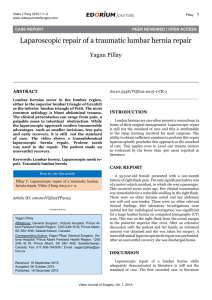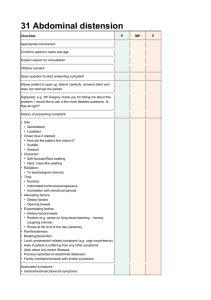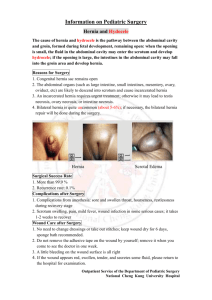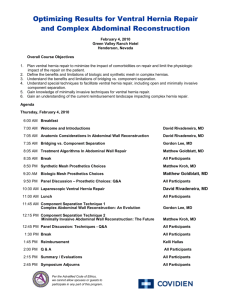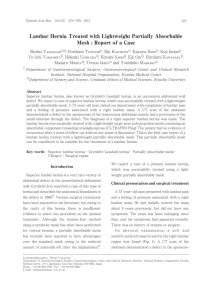Laparoscopic Repair of Lumbar Hernia: Case Report and
advertisement
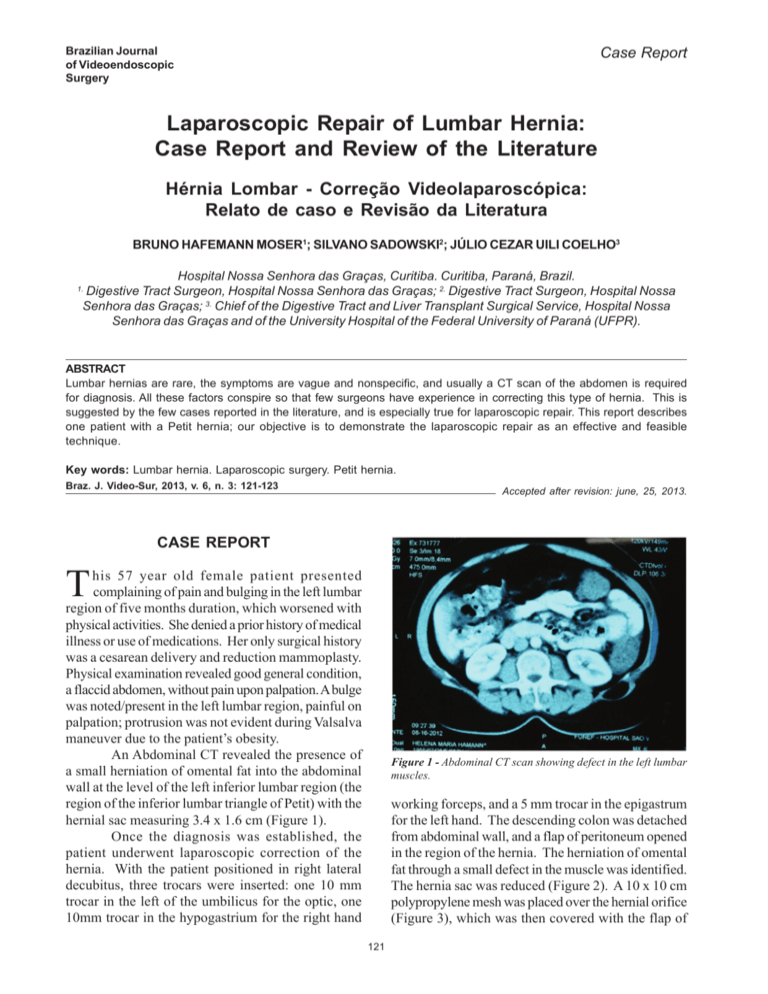
Brazilian Vol. 6, Nº 3Journal of Videoendoscopic Surgery Laparoscopic Repair of Lumbar Hernia: Case Report and Review of the Literature 121 Case Report Laparoscopic Repair of Lumbar Hernia: Case Report and Review of the Literature Hérnia Lombar - Correção Videolaparoscópica: Relato de caso e Revisão da Literatura BRUNO HAFEMANN MOSER1; SILVANO SADOWSKI2; JÚLIO CEZAR UILI COELHO3 Hospital Nossa Senhora das Graças, Curitiba. Curitiba, Paraná, Brazil. Digestive Tract Surgeon, Hospital Nossa Senhora das Graças; 2. Digestive Tract Surgeon, Hospital Nossa Senhora das Graças; 3. Chief of the Digestive Tract and Liver Transplant Surgical Service, Hospital Nossa Senhora das Graças and of the University Hospital of the Federal University of Paraná (UFPR). 1. ABSTRACT Lumbar hernias are rare, the symptoms are vague and nonspecific, and usually a CT scan of the abdomen is required for diagnosis. All these factors conspire so that few surgeons have experience in correcting this type of hernia. This is suggested by the few cases reported in the literature, and is especially true for laparoscopic repair. This report describes one patient with a Petit hernia; our objective is to demonstrate the laparoscopic repair as an effective and feasible technique. Key words: Lumbar hernia. Laparoscopic surgery. Petit hernia. Braz. J. Video-Sur, 2013, v. 6, n. 3: 121-123 Accepted after revision: june, 25, 2013. CASE REPORT T his 57 year old female patient presented complaining of pain and bulging in the left lumbar region of five months duration, which worsened with physical activities. She denied a prior history of medical illness or use of medications. Her only surgical history was a cesarean delivery and reduction mammoplasty. Physical examination revealed good general condition, a flaccid abdomen, without pain upon palpation. A bulge was noted/present in the left lumbar region, painful on palpation; protrusion was not evident during Valsalva maneuver due to the patient’s obesity. An Abdominal CT revealed the presence of a small herniation of omental fat into the abdominal wall at the level of the left inferior lumbar region (the region of the inferior lumbar triangle of Petit) with the hernial sac measuring 3.4 x 1.6 cm (Figure 1). Once the diagnosis was established, the patient underwent laparoscopic correction of the hernia. With the patient positioned in right lateral decubitus, three trocars were inserted: one 10 mm trocar in the left of the umbilicus for the optic, one 10mm trocar in the hypogastrium for the right hand Figure 1 - Abdominal CT scan showing defect in the left lumbar muscles. working forceps, and a 5 mm trocar in the epigastrum for the left hand. The descending colon was detached from abdominal wall, and a flap of peritoneum opened in the region of the hernia. The herniation of omental fat through a small defect in the muscle was identified. The hernia sac was reduced (Figure 2). A 10 x 10 cm polypropylene mesh was placed over the hernial orifice (Figure 3), which was then covered with the flap of 121 Moser et al. 122 Braz. J. Video-Sur., July / September 2013 peritoneum, which, in turn, was closed with metal clips (Figure 4). The patient was discharged on the same day of surgery after receiving medication for pain and tolerating food. At the three month postoperative follow-up the patient had no complaints, nor evidence of recurrence of the hernia. DISCUSSION Since the first description of lumbar hernia by Garengoet in 1731, this condition remains relatively rare.1 Before 1980, fewer than 300 cases of lumbar hernias had been reported in the literature. A review by Hsu et al. others found an additional 82 cases between 1989 and 2008.2,3 Dorsal and lumbar hernias account for less than 1% of abdominal wall hernias.4 Hafner et al5 suggested that a general surgeon was likely to have only one opportunity to treat a lumbar hernia in his life. Lumbar hernias can be: spontaneous (55%), traumatic (26%), and congenital (19%)1 and may occur in two areas of weakness in the postero-lateral abdominal wall: the superior lumbar triangle of Grynfeltt, which is most common site, and the inferior lumbar triangle of Petit.6 The superior lumbar triangle is an inverted triangle with its base bounded by the 12th rib and the lower edge of the serratus muscle, its posterior aspect defined by the sacrospinal muscle, its anterior aspect defined by the internal oblique muscle, its roof defined by the external oblique and latissimus dorsi, and its floor by the transversalis fascia. The inferior lumbar triangle is bounded by the iliac crest at its base, the external oblique muscle laterally, and the latissimus dorsi muscle medially, with its floor formed by the internal oblique muscle. The most common sign of lumbar hernia is a protrusion in the flank, which increases in size with physical activity or exertion and disappears when the patient is lying down. The patient may complain of a vague feeling of discomfort, abdominal pain and local tenderness.1,7 The differential diagnosis of lumbar hernia includes lipoma, hematoma, or abscess after trauma or surgery, as well as renal tumor. The spontaneous hernias are more common on the left side, but there are no scientific explanations for this.8,9 Computed tomography is a useful diagnostic tool in the differentiation of lumbar hernias offering several advantages. With CT it is possible to detect defects between the muscle and fascial layers, Figure 2 - Laparoscopic view of the orifice of the left lumbar hernia after reduction of the hernial sac. Figure 3 - Laparoscopic view of the left lumbar hernia after placement of the polypropylene mesh. Figure 4 - Laparoscopic view showing that the polypropylene mesh was covered with a flap of peritoneum. Vol. 6, Nº 3 Laparoscopic Repair of Lumbar Hernia: Case Report and Review of the Literature visualize the contents of the hernia, and exclude renal and other soft tissue tumors.2,10,11 The only available treatment is surgery laparoscopic access is an option. Since a case of 123 laparoscopic lumbar hernia repair was described by Heniford et al. in 1997,12 several others have been reported, either via laparoscopy or retro-peritoneoscopy.13,14 RESUMO As hérnias lombares são de ocorrência rara, os sintomas são vagos e inespecíficos e normalmente a tomografia computadorizada de abdômen é imprescindível para o diagnóstico. Todos esses fatores fazem com que poucos cirurgiões tenham experiência na correção deste tipo de hérnia, a julgar pelos poucos casos relatados na literatura, especialmente se considerarmos o reparo por vídeo-laparoscopia. O presente relato refere-se a uma paciente com diagnóstico de hérnia de Petit e o objetivo é demonstrar a correção por vídeo-laparoscopia como método eficaz e factível. Palavras chave: Hérnia lombar. Cirurgia laparoscópica. Hérnia de Petit. REFERENCES 1. 2. 3. 4. 5. 6. 7. 8. Nam SY, Kee SK, Kim JO. Laparoscopic transabdominal extraperitoneal mesh repair of lumbar hernia. J Korean Surg Soc 2011; 81(S): 74–77 Dc, GRL, & Deppert, E. Inferior lumbar triangle hernia as a rarely reported cause of low back pain: a report of 4 cases. Journal of Chiropractic Medicine 2010; 9(2): 73–76. Hsu SD, Shen KL, Liu HD, Chen TW, Yu JC. Lumbar hernia: clinical analysis of cases and review of the literature. Chir Gastroenterol 2008; 24:221-4. Malangoni MA, Gagliardi RJ. Hérnias. In: Townsend CM, Beauchamp RD, Evers BM, Mattox KL, editores. Sabiston – Tratado de cirurgia: A base biológica da prática cirúrgica moderna. 17ª ed. 2005. p.1199-1217. Hafner C, Wylie J Jr, Brush BE. Petit’s lumbar hernia: repair with Marlex mesh. Arch Surg. 1963; 86:180-186 Moreno-Egea A, Baena EG, Calle MC, Martínez JA, Albasini JL. Controversies in the current management of lumbar hernias. Arch Surg 2007; 142:82-8 Fontoura RD, Oliveira GA, Araújo ES, Sarmenghi Filho D, Kalil M. Hérnia de Petit bilateral espontânea. Rev Col Bras Cir 2011; 38(5). Grignon OAAHB, Hamel JMNO, & Rogez RRJM. (2008). Lumbar hernia: anatomical basis and clinical aspects. Surgical and Radiologic Anatomy 2008; 30(7): 533-537. 9. 10. 11. 12. 13. 14. Loukas M, Tubbs RS, El-Sefdy A, Jester A, Polepalli S, Kinsela C, Wu S. The clinical anatomy of the triangle of Petit. Hernia 2007; 11:441-444. Aguirre DA, Casola G, Sirlin C. Abdominal wall hernias: MDCT findings. AJR 2004; 183:681-90. Hickey NA, Ryan MF, Hamilton PA, Bloom C, Murphy HP, Brenneman F. Computed tomography of traumatic abdominal wall hernia and associated deceleration injuries. Can Assoc Radiol J 2002; 53(3):153-9. Heniford BT, Iannitti DA, Gagner M. Laparoscopic inferior and superior lumbar hernia repair. Arch Surg 1997; 132: 11414. Burick AJ, Parascandola SA. Laparoscopic repair of a traumatic lumbar hernia: a case report. J Laparoendosc Surg 1996; 6:259-62. Habib E. Retroperitoneoscopic tension-free repair of lumbar hernia. Hernia 2003; 7:150-2. Corresponding Author: BRUNO HAFEMANN MOSER Rua Rocha Pombo 36 / 507 Bairro Eugênio Schneider, Rio do Sul, SC - Brazil 89167-009 E-mail: brunorsul@yahoo.com.br Brazilian Journal of Videoendoscopic Surgery - v. 6 - n. 3 - Jul./Sep. 2013 - Subscription: + 55 21 3325-7724 - E-mail: revista@sobracil.org.br ISSN 1983-9901: (Press) ISSN 1983-991X: (on-line) - SOBRACIL - Press Graphic & Publishing Ltd. Rio de Janeiro, RJ-Brasil



